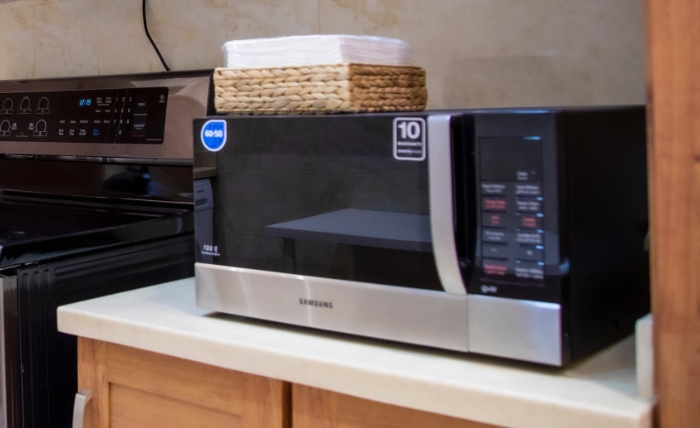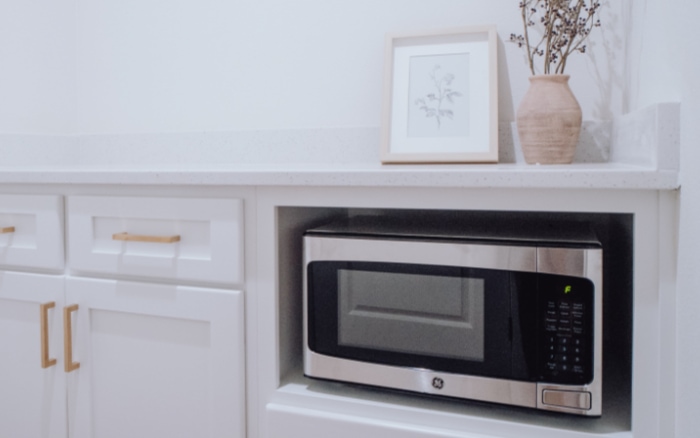Microwave Interferences With WiFi: Explained

Reliable and seamless WiFi connectivity has become an essential part of our daily lives. We depend on it for work, communication, entertainment, and many other aspects of modern living.
However, despite its ubiquity, WiFi technology is not immune to certain types of interference that can disrupt our online experience. One such surprising source of interference is the humble microwave oven—a staple appliance in households across the globe.
This blog post aims to shed light on how microwave ovens can interfere with WiFi signals, the symptoms of such interference, and the various solutions available to mitigate this issue.
By understanding and addressing this seemingly innocuous problem, we can optimize our WiFi performance and enhance our overall online experience.
Basics of Microwave and WiFi Technology
In this section, we’ll provide an overview of the fundamental concepts of microwave and WiFi technology. We’ll discuss the operating frequency of microwave ovens (2.4 GHz), how microwaves heat food, and the WiFi frequency bands (2.4 GHz and 5 GHz).
Microwave Ovens Operating Frequency (2.4 GHz)
Microwave ovens, designed for heating and cooking food, operate at a frequency of 2.4 GHz. This frequency range allows for optimal absorption of microwave energy by water molecules present in food, which in turn generates heat through a process called dielectric heating.
This frequency range is not exclusive to microwave ovens, however, as it is also utilized by other wireless communication technologies, including WiFi.
How Microwaves Heat Food
Microwave ovens generate electromagnetic waves at the 2.4 GHz frequency. These waves penetrate the food and interact with water, fat, and sugar molecules.
The microwave energy causes these molecules to vibrate rapidly, creating friction and heat. This process heats the food evenly and quickly, making microwave ovens an efficient and convenient choice for cooking and reheating meals.
WiFi Frequency Bands (2.4 GHz and 5 GHz)
WiFi technology primarily operates on two frequency bands—2.4 GHz and 5 GHz. The 2.4 GHz band, being lower in frequency, has a longer range and better penetration through walls and other obstacles.
However, it is more prone to interference due to the prevalence of other devices that operate on the same frequency range, such as microwave ovens, cordless phones, and Bluetooth devices.
On the other hand, the 5 GHz band offers higher data transfer rates and is less congested, but its range is shorter and it has reduced wall penetration.
Channel Selection and Usage
Both the 2.4 GHz and 5 GHz WiFi bands are divided into multiple channels. The 2.4 GHz band has 14 channels, with 11 of them available for use in most countries.
These channels overlap to some extent, which can lead to interference if multiple WiFi networks are operating on the same or nearby channels.
The 5 GHz band has more non-overlapping channels, reducing the likelihood of interference. Selecting the right channel for your WiFi network can significantly improve its performance and reduce the impact of interference from other devices, such as microwave ovens.
The Cause of Interference
Here, we’ll explain the primary cause of interference between microwave ovens and WiFi signals.
Shared Frequency Range (2.4 GHz)
One of the main reasons microwave ovens can interfere with WiFi signals is the shared frequency range of 2.4 GHz. Both microwave ovens and WiFi routers operating on the 2.4 GHz band use the same portion of the electromagnetic spectrum.
While microwave ovens are designed to contain the generated microwaves, some leakage can occur, especially in older or poorly maintained appliances. This leakage can create interference with nearby WiFi signals, leading to degraded performance.
Electromagnetic Waves and Interference
Electromagnetic waves, such as those produced by microwave ovens and WiFi routers, can interact with each other, causing interference.
When the waves from different sources overlap, they can either amplify or cancel each other out, depending on their phase relationship.
In the case of microwave ovens and WiFi routers, the interference can lead to reduced signal strength, disrupted connections, and slower data transfer rates.
Factors Affecting the Severity of Interference
Interference between microwaves and WiFi can vary in severity depending on several factors.
Microwave Oven Shielding
The shielding in a microwave oven is designed to prevent microwaves from leaking outside the oven. However, as microwave ovens age or become damaged, their shielding can become less effective, allowing more microwave energy to escape.
Poorly shielded microwave ovens are more likely to cause interference with WiFi signals.
Distance Between Devices
The distance between the microwave oven and the WiFi router or connected devices can also influence the severity of interference.
As the distance between the devices increases, the strength of the interfering microwave signal decreases. Maintaining a sufficient distance between your microwave oven and WiFi router can help minimize interference.
Obstacles and Room Layout
The layout of your home and the placement of obstacles, such as walls and furniture, can also affect the severity of microwave interference. Obstacles can either absorb or reflect microwave energy, reducing its impact on your WiFi network.
By carefully arranging your living space and positioning your WiFi router and microwave oven, you can optimize your network’s performance and reduce the likelihood of interference.
Symptoms of Microwave Interference
Microwave interference can manifest in various ways, impacting the performance of your WiFi network. In this section, we’ll outline common symptoms of microwave interference.
Slow Internet Speeds
One of the most noticeable symptoms of microwave interference is slow internet speeds. When a microwave oven is in use, it may cause a significant reduction in WiFi throughput, leading to sluggish browsing, buffering videos, and delayed file downloads.
This slowdown can be particularly noticeable if your WiFi router operates on the 2.4 GHz band, as it is more susceptible to interference from microwave ovens.
Connection Drops
Microwave interference can also cause connection drops, resulting in a temporary loss of internet connectivity for devices connected to the affected WiFi network.
These connection drops can be frustrating, as they may require users to reconnect to the network manually or wait for the connection to reestablish itself.
Latency and Packet Loss
Another symptom of microwave interference is increased latency and packet loss. Latency refers to the time it takes for data to travel from one point to another in a network.
Packet loss transpires when data packets sent across the network do not successfully arrive at their intended target.
Both latency and packet loss can negatively impact the overall performance of your WiFi network, causing stuttering audio, choppy video, and unresponsive webpages.
Real-Life Scenarios
Video Streaming
Microwave interference can be particularly disruptive when streaming video content. Slow internet speeds, increased latency, and packet loss can lead to frequent buffering, poor video quality, and audio syncing issues.
This can make watching your favorite shows and movies a frustrating experience.
Online Gaming
For online gamers, a stable and low-latency connection is essential. Microwave interference can cause high latency and packet loss, which can result in lag, delayed inputs, and even disconnections from the game server.
These issues can be detrimental to your gaming performance and enjoyment.
Video Conferencing
In today’s increasingly remote work environment, video conferencing has become a crucial communication tool.
Microwave interference can disrupt video conferences by causing frozen video, distorted audio, and dropped connections.
These disruptions can lead to miscommunication, reduced productivity, and frustration for all participants.
Solutions and Preventative Measures

In this section, we’ll discuss solutions and preventative measures to minimize microwave interference with your WiFi network.
Using the 5 GHz WiFi Band
Switching to the 5 GHz WiFi band can be an effective solution to mitigate microwave interference. Since microwave ovens operate at 2.4 GHz, using a WiFi router that supports the 5 GHz band can help you avoid interference issues.
The 5 GHz band also offers higher data transfer rates and is generally less congested, providing a better overall WiFi experience.
Relocate the Microwave or Router
The placement of your microwave oven and WiFi router can have a significant impact on the potential for interference. To minimize issues, consider relocating either the microwave or the router to create more distance between them.
Ideally, they should be placed in separate rooms or at opposite ends of a room.
Maintain Distance Between Devices
Maintaining a sufficient distance between your microwave oven and WiFi-connected devices can also help reduce interference.
If possible, avoid using WiFi devices near the microwave while it is in operation, as the closer a device is to the microwave, the more likely it is to experience interference.
Ensuring Proper Microwave Oven Shielding
Regularly inspect and maintain your microwave oven to ensure that its shielding is functioning effectively. Check for any visible damage, such as cracks or dents, which could compromise the oven’s ability to contain microwave energy.
If you suspect that your microwave oven’s shielding is inadequate or damaged, consider having it repaired or replaced to prevent interference with your WiFi network.
Changing WiFi Channels
Since WiFi routers operating on the 2.4 GHz band use multiple overlapping channels, interference from microwave ovens and other devices can sometimes be reduced by changing the channel on which your router operates.
Experiment with different channels to find the one that offers the least interference and best performance for your network.
Upgrading to a Dual-Band or Mesh WiFi System
If you continue to experience microwave interference despite implementing the above solutions, you may want to consider upgrading your WiFi setup.
A dual-band router, which supports both 2.4 GHz and 5 GHz frequencies, allows you to connect your devices to the less-congested 5 GHz band.
Alternatively, a mesh WiFi system can provide more comprehensive coverage and better performance throughout your home by using multiple interconnected nodes to create a seamless network.
These systems often support both frequency bands, further reducing the likelihood of interference from microwave ovens.
Conclusion
In this blog post, we have explored the phenomenon of microwave interference with WiFi signals, primarily caused by the shared 2.4 GHz frequency range between microwave ovens and WiFi routers.
We discussed the symptoms of interference, including slow internet speeds, connection drops, and latency issues, and how they can negatively impact real-life scenarios like video streaming, online gaming, and video conferencing.
Understanding the potential for microwave interference with WiFi is essential to ensuring a reliable and high-performing internet connection in your home or workspace.
By being aware of the causes and symptoms of interference, you can take appropriate steps to minimize its impact and maintain a stable WiFi network.
Implementing the suggested solutions, such as using the 5 GHz WiFi band, adjusting the placement of devices, ensuring proper microwave oven shielding, changing WiFi channels, or upgrading your WiFi system, can significantly improve your online experience.
We encourage you to take proactive measures to optimize your WiFi performance and reduce the likelihood of microwave interference.
By implementing the suggested solutions and preventative measures, you can create a more seamless and enjoyable online experience, whether you are streaming your favorite shows, participating in a crucial video conference, or enjoying an online gaming session.



